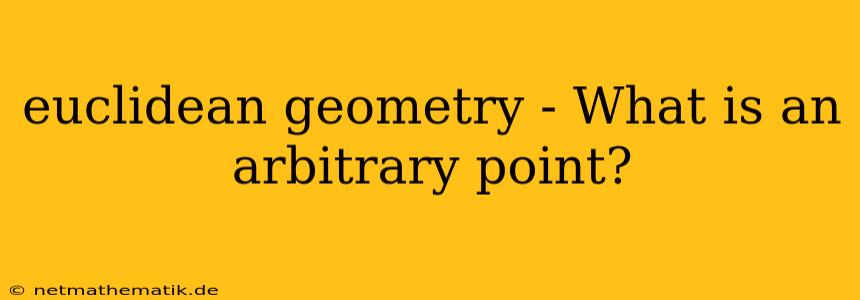In the realm of geometry, understanding the fundamental concepts is crucial for unraveling the intricate relationships between points, lines, and shapes. One such concept, often encountered in Euclidean geometry, is the notion of an arbitrary point. While it might seem straightforward, the concept of an arbitrary point carries significant implications for geometric proofs and constructions. This article delves into the definition, significance, and applications of arbitrary points in Euclidean geometry, providing a comprehensive understanding of this key element.
What is an Arbitrary Point?
In Euclidean geometry, an arbitrary point is a point that is not specifically defined or restricted in its location. It can be any point within the given geometric space, without any specific coordinates or constraints. It represents a generic point that can be chosen freely. For example, when dealing with a line segment, an arbitrary point could be any point on that line segment.
Significance of Arbitrary Points
The concept of arbitrary points holds immense significance in Euclidean geometry for several reasons:
- Generalization: Arbitrary points allow for the generalization of geometric proofs and constructions. By using an arbitrary point, we can demonstrate that a particular property or relationship holds true for any point within a specific region or on a particular shape.
- Flexibility: The use of arbitrary points provides flexibility in geometric proofs. By choosing arbitrary points, we can strategically position them to simplify the proof and make the relationships between geometric elements more apparent.
- Foundation for Further Concepts: The concept of arbitrary points serves as a foundation for more advanced geometric concepts, such as the definition of lines, angles, and shapes.
Examples of Arbitrary Points in Geometric Proofs
To illustrate the use of arbitrary points in geometric proofs, let's consider a few examples:
Example 1: Proving the Midpoint Theorem
The Midpoint Theorem states that the line segment joining the midpoints of two sides of a triangle is parallel to the third side and half its length. In a proof of this theorem, we would typically choose an arbitrary point on the third side of the triangle. We would then connect this arbitrary point to the midpoints of the other two sides, forming a parallelogram. By exploiting the properties of parallelograms, we can then demonstrate that the line segment joining the midpoints is parallel to the third side and half its length.
Example 2: Proving the Angle Bisector Theorem
The Angle Bisector Theorem states that the angle bisector of an angle of a triangle divides the opposite side in the ratio of the other two sides. To prove this theorem, we would typically choose an arbitrary point on the angle bisector and then draw lines connecting this arbitrary point to the endpoints of the opposite side. We would then use similar triangles to demonstrate that the ratio of the segments of the opposite side is equal to the ratio of the other two sides.
Applications of Arbitrary Points in Geometry
The concept of arbitrary points has wide-ranging applications in various branches of geometry:
- Analytic Geometry: Arbitrary points are used in analytic geometry to represent general points in the Cartesian plane or three-dimensional space. This allows for the development of algebraic equations to describe geometric shapes and relationships.
- Projective Geometry: Arbitrary points play a critical role in projective geometry, which deals with transformations that preserve lines and incidence relationships. In this context, arbitrary points are used to define projective spaces and to analyze geometric properties under projective transformations.
- Computational Geometry: Arbitrary points are extensively employed in computational geometry for tasks such as point-in-polygon tests, convex hull computations, and Voronoi diagram construction.
Conclusion
The concept of an arbitrary point is a fundamental and versatile tool in Euclidean geometry. By allowing for the selection of any point without specific constraints, arbitrary points facilitate general proofs, provide flexibility in geometric constructions, and form the basis for more complex geometric ideas. Their applications extend to various branches of geometry, highlighting their enduring significance in unraveling the intricate world of shapes and relationships. Understanding the concept of arbitrary points is essential for anyone seeking a deeper understanding of Euclidean geometry and its many applications.
